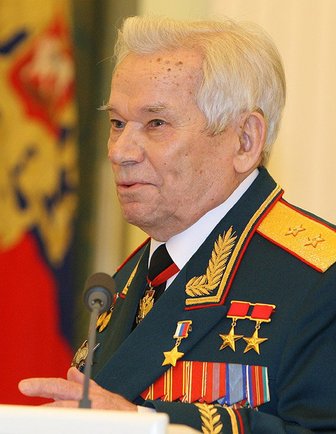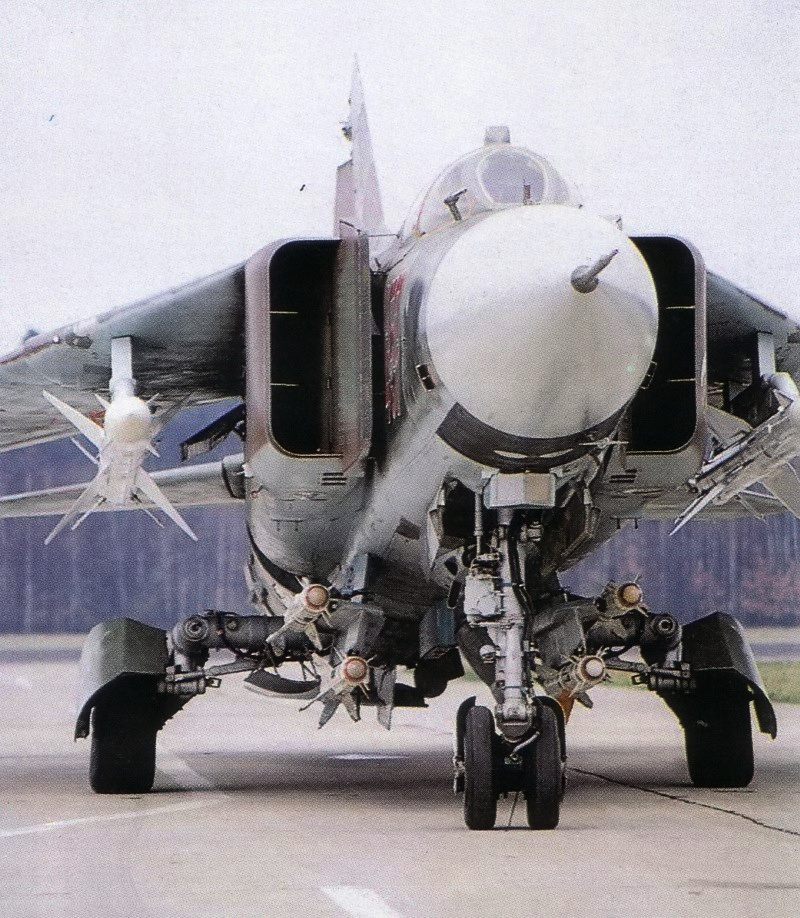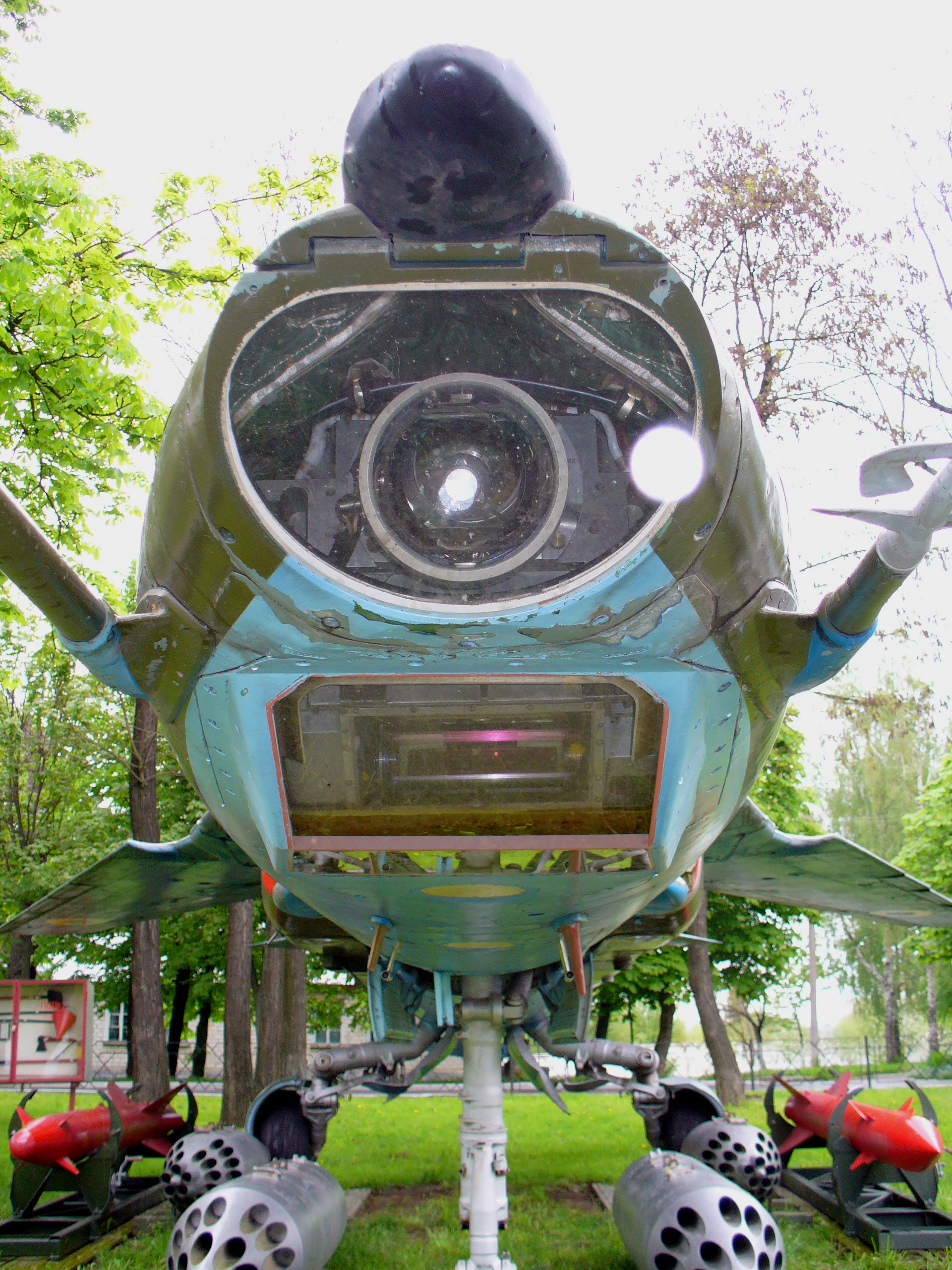|
372nd Fighter-Bomber Aviation Regiment
The 372nd Fighter-Bomber Aviation Regiment (372nd APIB) was a fighter-bomber regiment of the Soviet Air Forces and the Soviet Air Defence Forces (PVO). It existed from 1951 to 1993 and was based in Daugavpils until 1993, when it was transferred to Borisoglebsk and disbanded. History The 372nd Fighter Aviation Regiment was activated in October 1951 at Daugavpils Air Base, part of the 336th Fighter Aviation Division. It was equipped with the Mikoyan-Gurevich MiG-15. The regiment became part of the 175th Fighter Aviation Division in December 1952. In 1956, it received its first Mikoyan-Gurevich MiG-19 fighter aircraft and had replaced the MiG-15s by 1958. In 1960, it received the Yakovlev Yak-25 and became a PVO regiment, subordinated to the 27th Air Defence Corps. The MiG-15 and Yak-25 had been phased out by 1966, when the unit received the Yakovlev Yak-28P. In 1977, the regiment was transferred back to the Soviet Air Forces and became part of the Air Forces of the Baltic Mili ... [...More Info...] [...Related Items...] OR: [Wikipedia] [Google] [Baidu] |
Soviet Air Forces
The Soviet Air Forces ( rus, Военно-воздушные силы, r=Voyenno-vozdushnyye sily, VVS; literally "Military Air Forces") were one of the air forces of the Soviet Union. The other was the Soviet Air Defence Forces. The Air Forces were formed from components of the Imperial Russian Air Service in 1917, and faced their greatest test during World War II. The groups were also involved in the Korean War, and dissolved along with the Soviet Union itself in 1991–92. Former Soviet Air Forces' assets were subsequently divided into several air forces of former Soviet republics, including the new Russian Air Force. "March of the Pilots" was its song. Origins The ''All-Russia Collegium for Direction of the Air Forces of the Old Army'' (translation is uncertain) was formed on 20 December 1917. This was a Bolshevik aerial headquarters initially led by Konstantin Akashev. Along with a general postwar military reorganisation, the collegium was reconstituted as the "Workers' an ... [...More Info...] [...Related Items...] OR: [Wikipedia] [Google] [Baidu] |
27th Air Defence Corps
The 27th Air Defense Corps () was a corps of the Soviet Air Defense Forces and briefly the Russian Air Defense Forces. Formed in 1960 from the Baltic Air Defense Corps, the corps provided air defense for the Latvian and Lithuanian Soviet Socialist Republics. In the early 1970s it took over responsibility for Kaliningrad Oblast as well. Initially part of the 2nd Independent Air Defense Army, it was subordinated to the Air Forces of the Baltic Military District from the late 1970s to the mid-1980s. In 1986 the corps became part of the 6th Independent Air Defense Army, and was disbanded in 1994 after the Russian withdrawal from the Baltics following the end of the Cold War and the Dissolution of the Soviet Union. History In the summer of 1954, the air defense units in the Baltic states became part of the new Baltic Air Defense Corps of the Soviet Air Defense Forces, headquartered in Riga. In early 1957, the Baltic Air Defense Corps and the Air Defense Directorate of the Baltic ... [...More Info...] [...Related Items...] OR: [Wikipedia] [Google] [Baidu] |
Fighter Regiments Of The Soviet Air Defence Forces
Fighter(s) or The Fighter(s) may refer to: Combat and warfare * Combatant, an individual legally entitled to engage in hostilities during an international armed conflict * Fighter aircraft, a warplane designed to destroy or damage enemy warplanes in air-to-air combat ** Fighter pilot, a military aviator who controls a fighter aircraft * Martial artist, one who practices martial arts * Soldier, one who fights as part of a military * Warrior, a person specializing in combat or warfare Film and television * The Fighter (1921 film), an American silent film directed by Henry Kolker * ''The Fighters'' (1939 film), a Soviet drama film directed by Eduard Pentslin * ''The Fighter'' (1952 film), an American film noir boxing film directed by Herbert Kline * ''The Fighters'' (1974 film), a documentary film directed by Rick Baxter and William Greaves * ''The Fighter'' (1983 film), a television movie starring Gregory Harrison and Glynnis O'Connor * ''Fighter'' (2000 film), an American d ... [...More Info...] [...Related Items...] OR: [Wikipedia] [Google] [Baidu] |
Regiments Of The Soviet Air Forces
A regiment is a military unit. Its role and size varies markedly, depending on the country, service and/or a specialisation. In Medieval Europe, the term "regiment" denoted any large body of front-line soldiers, recruited or conscripted in one geographical area, by a leader who was often also the feudal lord ''in capite'' of the soldiers. Lesser barons of knightly rank could be expected to muster or hire a company or battalion from their manorial estate. By the end of the 17th century, infantry regiments in most European armies were permanent units, with approximately 800 men and commanded by a colonel. Definitions During the modern era, the word "regiment" – much like "corps" – may have two somewhat divergent meanings, which refer to two distinct roles: # a front-line military formation; or # an administrative or ceremonial unit. In many armies, the first role has been assumed by independent battalions, battlegroups, task forces, brigades and other, similarly s ... [...More Info...] [...Related Items...] OR: [Wikipedia] [Google] [Baidu] |
Treaty On Conventional Armed Forces In Europe
The original Treaty on Conventional Armed Forces in Europe (CFE) was negotiated and concluded during the last years of the Cold War and established comprehensive limits on key categories of conventional military equipment in Europe (from the Atlantic Ocean, Atlantic to the Ural Mountains, Urals) and mandated the destruction of excess weaponry. The treaty proposed equal limits for the two "groups of states-parties", the NATO, North Atlantic Treaty Organization (NATO) and the Warsaw Pact. In 2007, Russia "suspended" its participation in the treaty, and on 10 March 2015, citing NATO's ''de facto'' breach of the Treaty, Russia formally announced it was "completely" halting its participation in it as of the next day. History Background In 1972, US president Richard Nixon and Soviet General Secretary Leonid Brezhnev reached a compromise agreement to hold separate political and military negotiations.FEDERATION OF AMERICAN SCIENTISTS"Chronology: CFE Treaty Negotiations and Implementation, ... [...More Info...] [...Related Items...] OR: [Wikipedia] [Google] [Baidu] |
Sergey Borisyuk
{{Disambiguation ...
Sergey may refer to: * Sergey (name), a Russian given name (including a list of people with the name) * Sergey, Switzerland, a municipality in Switzerland * ''Sergey'' (wasp), a genus in subfamily Doryctinae The Doryctinae or doryctine wasps are a large subfamily of braconid parasitic wasps (Braconidae). Numerous genera and species formerly unknown to science are being described every year. This subfamily is presumably part of a clade containing o ... [...More Info...] [...Related Items...] OR: [Wikipedia] [Google] [Baidu] |
Hero Of The Russian Federation
Hero of the Russian Federation (russian: Герой Российской Федерации, Geroy Rossiyskoy Federatsii), also unofficially Hero of Russia (russian: link=no, Герой России, Geroy Rossii), is the highest honorary title of the Russian Federation. The title comes with a Gold Star medal, an insignia of honour that identifies recipients. The title is awarded to persons for "service to the Russian state and nation, usually connected with a heroic feat of valour". The title is bestowed by decree of the president of the Russian Federation. Russian citizenship or being in the service of the Russian state is not obligatory. The title was established in 1992 and, , was awarded more than 970 times, of which more than 440 were posthumously. History The title "Hero of Russia" is a successor to Hero of the Soviet Union (russian: link=no, Герой Советского Союза), which was established by Resolution of the Central Executive Committee of the Sovi ... [...More Info...] [...Related Items...] OR: [Wikipedia] [Google] [Baidu] |
Mikoyan-Gurevich MiG-23
The Mikoyan-Gurevich MiG-23 (russian: Микоян и Гуревич МиГ-23; NATO reporting name: Flogger) is a variable-geometry fighter aircraft, designed by the Mikoyan-Gurevich design bureau in the Soviet Union. It is a third-generation jet fighter, alongside similar Soviet aircraft such as the Su-17 "Fitter". It was the first Soviet fighter to field a look-down/shoot-down radar, the RP-23 Sapfir, and one of the first to be armed with beyond-visual-range missiles. Production started in 1969 and reached large numbers with over 5,000 aircraft built, making it the most produced variable-sweep wing aircraft in history. Today the MiG-23 remains in limited service with some export customers. The basic design was also used as the basis for the Mikoyan MiG-27, a dedicated ground-attack variant. Among many minor changes, the MiG-27 replaced the MiG-23's nose-mounted radar system with an optical panel holding a laser designator and a TV camera. Development The MiG-23's predec ... [...More Info...] [...Related Items...] OR: [Wikipedia] [Google] [Baidu] |
Mikoyan MiG-27
The Mikoyan MiG-27 (russian: Микоян МиГ-27; NATO reporting name: Flogger-D/J) is a variable-sweep ground-attack aircraft, originally built by the Mikoyan-Gurevich design bureau in the Soviet Union and later licence-produced in India by Hindustan Aeronautics as the ''Bahadur'' ("Valiant"). It is based on the Mikoyan-Gurevich MiG-23 The Mikoyan-Gurevich MiG-23 (russian: Микоян и Гуревич МиГ-23; NATO reporting name: Flogger) is a variable-geometry fighter aircraft, designed by the Mikoyan-Gurevich design bureau in the Soviet Union. It is a third-generati ... fighter aircraft, but optimised for air-to-ground attack. Unlike the MiG-23, the MiG-27 did not have widespread use outside Russia, as most countries opted for the Mikoyan-Gurevich MiG-23, Mikoyan-Gurevich MiG-23BN and Sukhoi Su-22 instead. It remains in service only with the Kazakh Air Forces in the ground attack role. All Russian, Indian, Sri Lankan and Ukrainian MiG-27s have been retire ... [...More Info...] [...Related Items...] OR: [Wikipedia] [Google] [Baidu] |
Air Forces Of The Baltic Military District
The 15th Air Army was a military formation of the Soviet Air Forces, active from July 1942 until December 1993. History It was formed between 11 July and 15 August 1942, in accordance with the directive of the commander of the Soviet Air Force of 10 July 1942, on the basis of the Air Force of the Bryansk Front. The formation of the army began in the village of Pavlovka (18 km southeast of the city of Yelets) in the Lipetsk Oblast. The 15th Air Army received its baptism of fire in the autumn of 1942, participating in the defensive battles near Voronezh and in the elimination of the enemy's foothold on the left bank of the Don. In the winter of 1943, it supported the front troops in the Voronezh–Kastornoye operation. In May 1943 it participated in an air operation to destroy German aircraft at airfields. In July-August 1943, as part of the Battle of Kursk, she participated in the Orlov Strategic Offensive, and in September 1943, it supported the front troops in the Bryans ... [...More Info...] [...Related Items...] OR: [Wikipedia] [Google] [Baidu] |
Yakovlev Yak-28
The Yakovlev Yak-28 (russian: Яковлев Як-28) is a swept wing, turbojet-powered combat aircraft used by the Soviet Union. Produced initially as a tactical bomber, it was also manufactured in reconnaissance, electronic warfare, interceptor, and trainer versions, known by the NATO reporting names Brewer, Brewer-E, Firebar, and Maestro respectively. Based on the Yak-129 prototype first flown on 5 March 1958, it began to enter service in 1960. Design and development The Yak-28 was firstTaylor 1976, pp. 520–521. seen by the West at the Tushino air show in 1961. Western analysts initially believed it to be a fighter rather than an attack aircraft—and a continuation of the Yak-25M—and it was designated "Flashlight". After its actual role was realized, the Yak-28 bomber series was redesignated "Brewer". The Yak-28 had a large mid-mounted wing, swept at 45 degrees. The tailplane set halfway up the vertical fin (with cutouts to allow rudder movement). Slats were fitted ... [...More Info...] [...Related Items...] OR: [Wikipedia] [Google] [Baidu] |




.jpg)